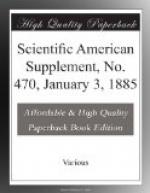It is characteristic of this group of organic forms that multiplication by self-division is the common and continuous method of increase. The other and essential method was comparatively rare and always obscure. In this instance, on the first occasion the continuous observation of the same “field” for five days failed to disclose to us any other method of increase but this multiple-fission, and it was only the intense suggestiveness of past experience that kept us still alert and prevented us from inferring that it was the only method. But eventually we perceived that while this was the prevailing phenomenon, there were scattered among the other forms of the same monad larger than the rest, and with a singular granular aspect toward the flagellate end. It may be easily contrasted with the normal or ordinary form. Now by doggedly following one of these through all its wanderings a wholly new phase in the morphology of the creature was revealed. This roughened or granular form seized upon and fastened itself to a form in the ordinary condition. The two swam freely together, both flagella being in action, but it was shortly palpable that the larger one was absorbing the lesser. The flagellum of the smaller one at length moved slower, then sluggishly, then fell upon the sarcode, which rapidly diminished, while the bigger form expanded and became vividly active until the two bodies had actually fused into one. After this its activity diminished, in a few minutes the body became quite still, leaving only a feeble motion in the flagellum, which soon fell upon the body-substance and was lost. All that was left now was a still spheroidal glossy speck, tinted with a brownish yellow. A peculiarity of this monad is the extreme uncertainty of the length of time which may elapse before even the most delicate change in this sac is visible. Its absolute stillness may continue for ten or more hours. During this time it is absolutely inert, but at last the sac—for such it is—opens gently, and there is poured out a brownish glairy fluid. At first the stream is small, but at length its flow enlarges the rift in the cyst, and the cloudy volume of its contents rolls out, and the hyaline film that inclosed it is all that is left.




